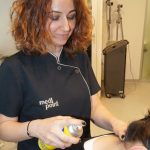Manipulation – Mobilization
 Manipulation therapy means treatment provided by the hands (“manus” in Latin). For any mechanical condition on the spine and other joints, manipulative treatment can be used. Some of the people known to provide treatment spinal and cervical disc herniation without being a doctor usually utilize manipulative treatment methods. Manipulation treatment is highly effective if performed by a well trained specialist. It may also cause severe problems in the cases of malpractice. It is not quite a favorable treatment method for specialists on musculoskeletal system (physical therapy specialists, orthopedists) as this method may rarely turn out badly (increased pain). Manipulation treatment is mostly used for locked spine, limitation of movement due to segmental dysfunctions, sacroiliac joint dysfunctions and spinal and cervical disc herniations. It is also indicated for limitation of movement on joints such as knee, shoulder. Manipulative treatment includes various techniques. Quick thrust and muscle energy can be described as the most common used techniques. Although it does not quite correspond to the definition of manipulation, stretching via cold spray which is a very common practice for the treatment of myofascial pain syndrome can also be accepted as a manipulation technique. Myofascial pain syndrome on the neck is especially very common. Trapezius and posterior neck muscles are the ones most affected. Intramusculartaut bands develop and cause pain on the neck and headaches. Myofascial pain can develop secondary to spinal and cervical disc herniation and other painful conditions as well as overuse of the relevant area. Stretching via cold spray is very effective for these cases.
Manipulation therapy means treatment provided by the hands (“manus” in Latin). For any mechanical condition on the spine and other joints, manipulative treatment can be used. Some of the people known to provide treatment spinal and cervical disc herniation without being a doctor usually utilize manipulative treatment methods. Manipulation treatment is highly effective if performed by a well trained specialist. It may also cause severe problems in the cases of malpractice. It is not quite a favorable treatment method for specialists on musculoskeletal system (physical therapy specialists, orthopedists) as this method may rarely turn out badly (increased pain). Manipulation treatment is mostly used for locked spine, limitation of movement due to segmental dysfunctions, sacroiliac joint dysfunctions and spinal and cervical disc herniations. It is also indicated for limitation of movement on joints such as knee, shoulder. Manipulative treatment includes various techniques. Quick thrust and muscle energy can be described as the most common used techniques. Although it does not quite correspond to the definition of manipulation, stretching via cold spray which is a very common practice for the treatment of myofascial pain syndrome can also be accepted as a manipulation technique. Myofascial pain syndrome on the neck is especially very common. Trapezius and posterior neck muscles are the ones most affected. Intramusculartaut bands develop and cause pain on the neck and headaches. Myofascial pain can develop secondary to spinal and cervical disc herniation and other painful conditions as well as overuse of the relevant area. Stretching via cold spray is very effective for these cases.
Mobilization is a manual therapy for eliminating the limitations of movement on the joints. It differs from the manipulation technique with steady motions instead of quick thrusts.
There are various mobilization techniques.  Mobilization technique is most commonly used on the shoulder, knee, ankle and hand joints. It provides the biggest efficacy on conditions such as frozen shoulder and joint stiffness which develops after the removal of plaster casts and post-surgically. Mobilization techniques provide even more efficacy when combined with physical therapy. Especially deep heat applications prepare the joints for mobilization therapy and accelerates recovery. Just like physical therapy, mobilization can be applied repetitively based on the condition of the joint. Mobilization techniques, in combination with physical therapy, are about to become a standard practice for the treatment of joint stiffness. It is usually practiced by physiotherapists.
Mobilization technique is most commonly used on the shoulder, knee, ankle and hand joints. It provides the biggest efficacy on conditions such as frozen shoulder and joint stiffness which develops after the removal of plaster casts and post-surgically. Mobilization techniques provide even more efficacy when combined with physical therapy. Especially deep heat applications prepare the joints for mobilization therapy and accelerates recovery. Just like physical therapy, mobilization can be applied repetitively based on the condition of the joint. Mobilization techniques, in combination with physical therapy, are about to become a standard practice for the treatment of joint stiffness. It is usually practiced by physiotherapists.

